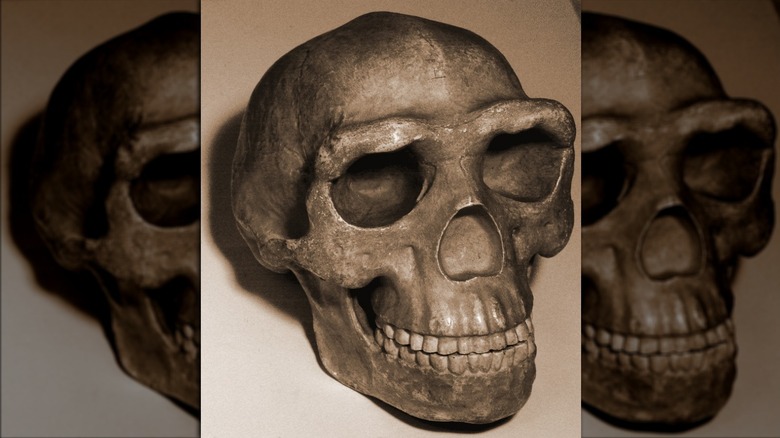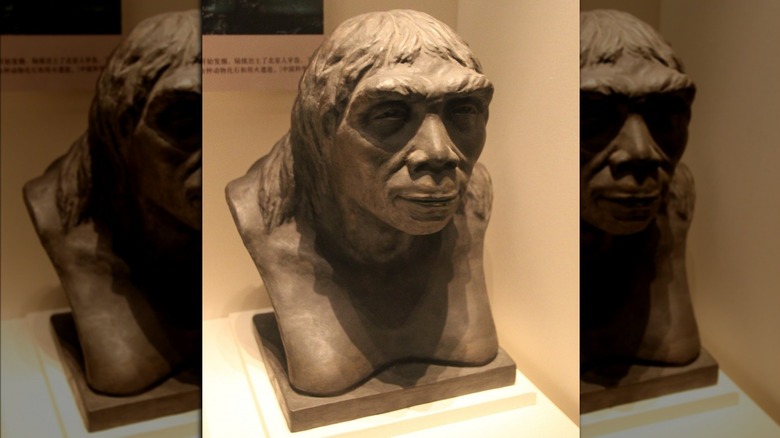The Real Reason We Can't Find The Lost Peking Man Fossils
How would you feel if you lost two crates full of priceless, ancient fossils? That's exactly what happened to the fossils of "Peking Man" (or Homo erectus pekinensis), a subspecies of Homo erectus. The first Peking Man fossils were found in the 1920s in the Zhoukoudian cave system outside the Chinese city of Beijing. (At the time, "Beijing" was known in English as "Peking," hence the name of the subspecies.)
Per NewScientist, the Peking Man fossils found in the Zhoukoudian cave system were believed to be over 500,000 years old. At the time, this made them the oldest hominid fossils ever found, representing some of the earliest human ancestors to use tools and wield fire. Anthropologists hoped to further study the fossils to learn many things about our distant ancestors, including whether they practiced cannibalism or were able to use language.
In September of 1941, the fossils met an uncertain fate. At that time, World War II was raging in Asia, and the Imperial Japanese Army was in the process of invading mainland China. To protect the Peking Man fossils from destruction, it was decided that they'd be sent to the United States. The fossils were to be transported over land to a U.S. Marine Base, then shipped over the Pacific to America. Following the plan, Chinese anthropologist Hu Chengzhi loaded the fossils — 200 of them, per Smithsonian Magazine — into crates. He was the last person to lay eyes on them.
The Peking Man fossils got lost as they were being shipped out of China
No one knows exactly what happened to the Peking Man fossils. The crates left Beijing, but never made it to the naval port. Per NewScientist, one historian suspects that the fossils were loaded onto a port-bound train, but that train was captured by Japanese soldiers. After that point, the fossils would have been discarded, sold, or even used by Chinese locals in traditional medicine.
Other theories suggest that the fossils were captured by the Japanese and loaded onto the steamship Awa Maru, and now lie at the bottom of the ocean with the wreck of that ship, torpedoed by an American submarine on April 1, 1945 (per NSA). Or maybe they did make it onto an American ship, but that ship also sank.
Rumors about the fate of the fossils abound, placing them somewhere in China, Japan, Taiwan, or the United States. Normally, that's where the story would end: The fossils are lost and we have no clue what happened to them. But a recent revelation may shed some light on their fate.
The bones may be under a Chinese parking lot
According to Smithsonian Magazine, a possible breakthrough in this mystery came in 2010, when the son of a former U.S. Marine contacted a South African anthropologist. He revealed that his father, Richard Bowen, had been stationed at the Chinese port city of Qinhuangdao in 1947.
By then, World War II had ended, but China was still at war — this time, a civil war between the Nationalists and the Communists. When the fighting reached Qinhuangdao, Bowen's corps were ordered to dig foxholes in order to hide from the gunfire. Digging one such hole, the group uncovered a box of bones. Bowen felt a bit spooked, but recalls that they didn't think much of it at the time, and that they filled the hole back up.
After receiving this tip in 2010, the anthropologist decided to investigate further, and contacted two of his Chinese colleagues. The small team went to the site of the Qinhuangdao Marine base where Bowen had been stationed. They found that the area was now an industrial hub. Tracing Bowen's steps based on his son's descriptions, they located the exact area where he most likely dug up the box of bones. It's now covered by a large parking lot.
The team of anthropologists didn't go through the trouble of gaining permission to dig up the lot. However, the area is scheduled to be renovated soon, and local officials have promised to keep an eye out for mysterious boxes of bones.


